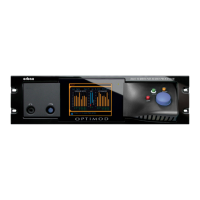3-4
OPERATION ORBAN MODEL 8685
Introduction to Processing
Some Audio Processing Concepts
Reducing the peak-to-average ratio of the audio increases loudness. If peaks are re-
duced, the average level can be increased within the permitted modulation limits.
The effectiveness with which this can be accomplished without introducing objec-
tionable side effects (like pumping or intermodulation distortion) is the single best
measure of audio processing effectiveness.
Compression reduces the difference in level between the soft and loud sounds to
make more efficient use of permitted peak level limits, resulting in a subjective in-
crease in the loudness of soft sounds. It cannot make loud sounds seem louder.
Compression reduces dynamic range relatively slowly in a manner similar to riding
the gain. Limiting and clipping, on the other hand, reduce the short-term peak-to-
average ratio of the audio.
Limiting increases audio density. Increasing density can make loud sounds seem
louder, but can also result in an unattractive busier, flatter, or denser sound. It is im-
portant to be aware of the many negative subjective side effects of excessive density
when setting controls that affect the density of the processed sound.
Clipping sharp peaks does not produce any audible side effects when done moder-
ately. Excessive clipping will be perceived as audible distortion.
Look-ahead limiting is limiting that prevents overshoots by examining a few milli-
seconds of the unprocessed sound before it is limited. This way the limiter can an-
ticipate and control peaks that are coming up.
In Dolby Digital transmission channels, appropriate setting of the
D
IALNORM metadata parameter will allow enough headroom to keep peak
levels below the threshold of the 8685’s look-ahead peak limiters. The
best sounding limiting is no limiting at all.
Distortion in Processing
In a competently designed processor, distortion occurs only when the processor is
controlling peaks to prevent the audio from exceeding the peak modulation limits
of the transmission channel. The less peak control that occurs, the less likely that the
listener will hear distortion. However, to reduce the amount of peak control, you
must decrease the drive level to the peak limiter, which causes the average level
(and thus, the loudness) to decrease proportionally.
Loudness and Distortion
In processing, there is a direct trade-off between loudness and distortion. You can
improve one only at the expense of one or both of the other two. Thanks to Orban’s
psychoacoustically optimized designs, this is less true of Orban processors than of
any others. Nevertheless, all intelligent processor designers must acknowledge and
work within the laws of physics as they apply to this trade-off.
In AM and FM processing, we have long said that there is a direct trade-
off between loudness, brightness, and distortion, However, because DTV,
DAB and netcasting systems don’t use preemphasis, there is no problem

